By David P. Diaz, Ed.D.
BACKGROUND AND INTRODUCTION
Anyone who has taken a cursory glance at this website is probably aware that I believe in God (see Diaz 2017, “God v. Matter as the Cause of the Universe” – Part 1 and Part 2). That makes me a “theist” (i.e., one who believes in the existence of God). While there are many forms of theism (pantheism, polytheism, deism, etc.), I have come to firmly believe in the existence of one God (monotheism), and more specifically, the God of Christian theism.1 Nevertheless, believing and rationally demonstrating the existence of God are two different concepts. Belief can sometimes be quite subjective, such that the object of one’s belief may, in fact, be untrue or—in the case of God—non-existent. Therefore, the process of rationally demonstrating the existence of God, or at least demonstrating a certain level of probability for His existence, may involve multiple lines of argumentation including the use of reasoned discourse, logical proofs, historical evidence, empirical evidence, mathematical solutions, statistical significance, and many, many others. In short, if one wants to hold a rational belief in the existence of God, one will have to expend no little amount of effort. In this brief paper, I will discuss one method for arguing for the existence of God: a cosmological argument.2

One of the dilemmas that have faced Christian theism since the founding of the Church is the question of God’s existence. Either God exists and created the universe and everything in it, or He does not exist and the Bible is reduced to mere literature and perhaps some platitudes that may not even be relevant in today’s world. To commit one’s life to a God who is not there is, at best, a salve for one’s fear of the unknown and, at worst, a delusion of epic proportions. On the other hand, not to commit one’s life to a God who is there may have both temporal and eternal consequences. Therefore, demonstrating God’s existence to unbelievers has been a critical aspect of Christian apologetics since the beginning.
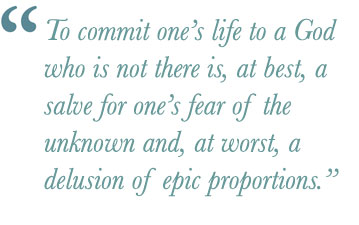
Nevertheless, the opening verse of the book of Genesis makes an unequivocal statement about a God who is there and about what He can do: “In the beginning God created the heavens and the earth.” This statement is a straightforward assertion about an eternal (Ps. 90:2), all-powerful (Lk. 1:37; 18:27) being or, at least, a being powerful enough to have created everything in the universe.
How should one answer the primordial question about the universe: “Why is there something rather than nothing?” (Leibneiz 1969, 639). Christian theism asserts that in the beginning, an all-powerful, transcendent being created the physical world of space and time. But what makes the God of Christian theism any more likely to exist than the gods of other worldviews?3
The Principles of Sufficient Reason and Causality
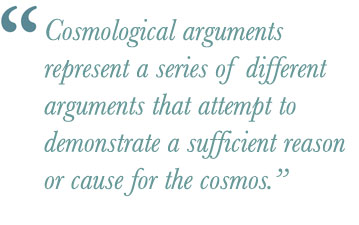
Many deny that God caused the universe because they see this idea as contradictory to the principle of sufficient reason, which affirms that everything that exists must have a reason, cause, or ground. In other words, if everything needs a reason, cause, or ground, the skeptic might well ask, “What caused God?” Thomas Aquinas (AD 1225–1274), arguably the most influential theologian of the Middle Ages, argued that only finite, limited, contingent beings4 need a cause. That is, only those things that have a beginning need a cause. According to Aquinas, a regression of causes can legitimately stop at a first cause or uncaused causer of all finite things; a necessary being.5 This view places a distinction between the principle of sufficient reason, which claims that everything (including God) must have a cause, and the principle of causality, which claims that only finite, changing, contingent substances need a cause. According to Aquinas, God is a necessary being—who needs no cause—while the universe (and everything in it) represents contingent substances, which need a cause. The problem with this line of reasoning is that skeptics can simply assign the title of necessary being to the material universe itself. Indeed, atheists often regard the universe as a factually necessary being. According to Craig (2012, 81): “Atheists have not felt compelled to embrace the view that the universe came into being out of nothing for no reason at all; rather, they regard the universe itself as a sort of factually necessary being.” Indeed, Cleanthes (c. 330–230 BC) stated: “[W]hy may not the material universe be the necessarily existent Being…?” (cited in Hume 2013, 64). Thus, in the face of these counterclaims, the Christian theist may choose to demonstrate that the universe most likely had a beginning and is therefore finite and in need of a cause. Enter the kalam cosmological argument.6
Cosmological arguments represent a series of different arguments that attempt to demonstrate a sufficient reason or cause for the cosmos. According to Craig and Sinclair (2012):
Cosmological arguments can be conveniently grouped into three basic types: the kalam cosmological argument for a First Cause of the beginning of the universe; the Thomist cosmological argument for a sustaining Ground of Being of the world; and the Leibnizian cosmological argument for a Sufficient Reason why something exists rather than nothing.
Arguing for the existence of God typically involves many different parts and directions of argumentation. In my example, the kalam cosmological argument can be used as a first step, which will then be followed by a number of other lines of reasoning. The following arguments will attempt to show that: (1) The universe had a beginning and therefore needed a First Cause. (2) The First Cause of the universe possesses some of the same characteristics as the God of Christian theism. And, therefore (3), the First Cause is probably the God of Christian theism.
THE KALAM COSMOLOGICAL ARGUMENT
The kalam cosmological argument does not attempt to prove the existence of God but, instead, attempts to prove that the universe began to exist. In other words, it aims to show that the universe is finite and therefore must have been caused by something other than itself. The kalam argument addresses claims by skeptics who say that the universe has always existed and, therefore, any appeal to God is unnecessary.7 The kalam cosmological argument goes something like this:8
- Whatever begins to exist had a cause of its existence.
- The universe began to exist.
- Therefore, the universe had a cause of its existence.
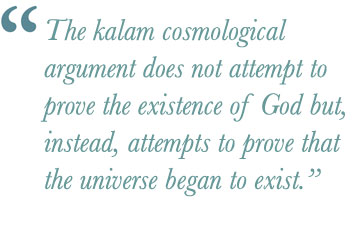 Premise 1 seems self-evident. An effect (i.e., that which begins to exist) is, by definition, that which is caused. Thus, everything in the world that exists had a cause, which also had a cause, and so on. It’s important to understand why the universe cannot arise from nothing but must have a cause. Nothingness is exactly that—no-thing. It is the complete opposite of something (substance); it has no properties and therefore does not exist. Though nothingness may be an idea that we can think about and perhaps formulate a concept of in our minds, it has no existential reality and no properties that would mark it as that which exists in the real world. This notion of something coming from nothing is contrary to all of human experience and to the scientific enterprise itself, which seeks causal explanations for all events. For every effect, there must have been some action (cause) that moved it from a state of potentiality to a state of actuality. Therefore, the idea that something (i.e., that which exists) can come from nothing (i.e., that which doesn’t exist) is mere fancy. Causality is a universal part of human experience—a universal norm—that is either self-evident or reducible to the self-evident. If the universe had a beginning, then it must have had a cause.
Premise 1 seems self-evident. An effect (i.e., that which begins to exist) is, by definition, that which is caused. Thus, everything in the world that exists had a cause, which also had a cause, and so on. It’s important to understand why the universe cannot arise from nothing but must have a cause. Nothingness is exactly that—no-thing. It is the complete opposite of something (substance); it has no properties and therefore does not exist. Though nothingness may be an idea that we can think about and perhaps formulate a concept of in our minds, it has no existential reality and no properties that would mark it as that which exists in the real world. This notion of something coming from nothing is contrary to all of human experience and to the scientific enterprise itself, which seeks causal explanations for all events. For every effect, there must have been some action (cause) that moved it from a state of potentiality to a state of actuality. Therefore, the idea that something (i.e., that which exists) can come from nothing (i.e., that which doesn’t exist) is mere fancy. Causality is a universal part of human experience—a universal norm—that is either self-evident or reducible to the self-evident. If the universe had a beginning, then it must have had a cause.
But what about premise 2, did the universe, indeed, have a beginning? Many believe that our universe is infinite, that it has always existed and therefore needed no cause. This is why the second premise is the most crucial assertion of the argument. The kalam argument presents two independent philosophical arguments in support of this premise and two scientific confirmations of the arguments (i.e., scientific evidence that also supports premise 2).
Actual Versus Potential Infinite
To understand the kalam argument, one must first understand the two types of infinity: potential and actual. A potential infinite represents a group of things (e.g., numbers, years, marbles, etc.) that continue toward infinity but never get there. A potential infinite is, in this sense, an endless process that at any given point along the way is finite but can never reach a last (or first) cause. Therefore, a potential infinite never becomes an actual infinite but is always finite! Of course, this simply won’t do as an explanation for an infinitely existing universe because it leads to an infinite regress of causes, which does not concur with the findings of current science nor does it conform to the canons of rational thought (as we will see below).
On the other hand, an actually infinite set is (theoretically) a completed group (set) of things that has an infinite number of members. In other words, the set is complete but also consists of an infinite number of things (kind of like the idea that there exist an infinite number of points between the two ends of a ruler). While this concept is used in certain types of mathematics, an actual infinite number of things cannot exist in the real world because it reduces to an absurdity, a fact that will be explained by the kalam argument.
The First Supporting Argument
The first supporting argument is: an actual infinite number of things cannot exist. To explain why an actual infinite cannot exist, it helps to assume—for the sake of argument—that it does exist and then show why this results in absurd consequences. For example, consider a hypothetical library with an assumed actual infinite number of red and black books (see Moreland 1987, 22–30). The number of members can never change in an actually infinite set because it is always infinite, therefore, no matter what happens, the library will always have an infinite number of books. Let’s also say that each book in the library has an infinite number of pages; there would be just as many pages in the first book in the library as there are in the entire infinite collection. Of course, it makes no sense to say there are as many red books as there are red and black books combined, or that there are the same number of pages in one book as in all the rest, but this is the claim for an actual infinite set because if you remove all the black books from the library, you still have an infinite number of books and pages in the set. This demonstrates the futility of the concept of actual infinity for describing things in the real world, especially as a proposed explanation of an infinite universe. While it may serve as a useful concept in set theory, it is unlikely that an actual infinite has a complement in the physical world around us.
The Second Supporting Argument
The second supporting argument is based on the impossibility of forming an actual infinite by successive addition. If one starts by adding one number at a time (or, in the case of the universe, working our way backward one day, one month, or one year at a time), one can never reach an actual infinite through successive addition because one can always add one more member (i.e., day, month, year, etc.). As mentioned above, this leads to an infinite regress or never-ending series of causes, which is the definition of a potential infinite (i.e., something that moves toward infinity but never reaches it).
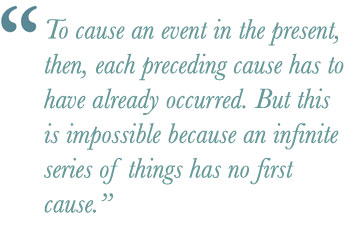 Now, let’s take a look at the practical problem of never arriving at an actual infinite through successive addition. For each event that is occurring in the universe at the present moment, (1) there was a cause, and for that event (2) there was another cause, which resulted from (3) another cause, which was brought about by (4) another cause, and so on into the never-ending stream of events (this is the essence of determinism). The chain of preceding causes can be traced backward but never reaches a first cause because you can always add one more cause. The conundrum is this: if just one of these preceding events has not already happened (i.e., been caused or actualized), then the event in the present could never have occurred. This chain of events had to have a first member (i.e., first cause) because, without a first member, there could be no second, third, or nth member. To cause an event in the present, then, each preceding cause has to have already occurred. But this is impossible because an infinite series of things has no first cause.
Now, let’s take a look at the practical problem of never arriving at an actual infinite through successive addition. For each event that is occurring in the universe at the present moment, (1) there was a cause, and for that event (2) there was another cause, which resulted from (3) another cause, which was brought about by (4) another cause, and so on into the never-ending stream of events (this is the essence of determinism). The chain of preceding causes can be traced backward but never reaches a first cause because you can always add one more cause. The conundrum is this: if just one of these preceding events has not already happened (i.e., been caused or actualized), then the event in the present could never have occurred. This chain of events had to have a first member (i.e., first cause) because, without a first member, there could be no second, third, or nth member. To cause an event in the present, then, each preceding cause has to have already occurred. But this is impossible because an infinite series of things has no first cause.
Therefore, based on these two philosophical arguments, the universe could not be infinite and therefore must have had a beginning. But the kalam argument does not end there. There are two scientific confirmations that add evidence and weight to the philosophical arguments that the universe must have had a beginning.
The First Scientific Confirmation
The first scientific confirmation comes from expansion theory. This theory has its roots in the works of Alexander Friedman and Georges Lemaître who, using the general theory of relativity, predicted that space would continue to expand and become less and less dense. For our purposes, the implication of this finding is, if you reverse the process, you arrive at a beginning where the universe was compressed into the highest possible density. This condensed state, the initial singularity,9 constituted the beginning of the universe (Craig 2012, 88). In 1929, Edwin Hubble—an American astronomer—added experimental support to expansion theory by demonstrating that the light at the far end of galaxies is shifting toward the red end of the spectrum, indicating that the light sources are receding from view (Davies 1984, 12–13). No matter which direction one looks, distant galaxies are moving rapidly apart. And, if the universe is expanding, it must have once existed in a contracted state. Hubble’s observations pointed to a time when the universe was incredibly small and just as dense (Carroll 2017, 50). The subsequent eruption has been referred to as the “big bang.” Thus, expansion theory provides evidence that the universe had a beginning.
The Second Scientific Confirmation
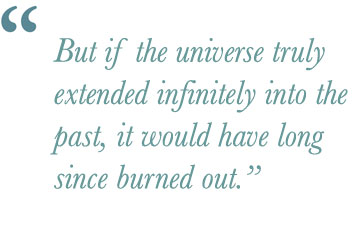 The second scientific confirmation comes from the second law of thermodynamics, which states that in a closed system,10 energy will eventually reach a state of equilibrium. That is, as energy is transferred or transformed, more and more of it is wasted and becomes unusable. The Second Law also states that there is a natural tendency of any isolated system to degenerate into a more disordered state (entropy). As usable energy decreases and unusable energy increases, “entropy” increases. If the universe continues to expand, it will eventually run out of usable energy, at which time the universe will come to an end in “heat death.” The implication is that our universe had a beginning at a finite point in the past and will eventually become inert at some point in the future. But if the universe truly extended infinitely into the past, it would have long since burned out.
The second scientific confirmation comes from the second law of thermodynamics, which states that in a closed system,10 energy will eventually reach a state of equilibrium. That is, as energy is transferred or transformed, more and more of it is wasted and becomes unusable. The Second Law also states that there is a natural tendency of any isolated system to degenerate into a more disordered state (entropy). As usable energy decreases and unusable energy increases, “entropy” increases. If the universe continues to expand, it will eventually run out of usable energy, at which time the universe will come to an end in “heat death.” The implication is that our universe had a beginning at a finite point in the past and will eventually become inert at some point in the future. But if the universe truly extended infinitely into the past, it would have long since burned out.
A more recent update to expansion theory—the theory of dark energy—asserts that the expansion rate is now speeding up. That is, dark energy, which is thought to permeate all of space (comprising 70 percent of the total energy of the universe), acts like antigravity to allow space to expand more and more rapidly. The realization of this theory means that the universe will likely expand forever and with increasing speed (Dienes 2017). And yet, this theory, too, assumes that the universe had a beginning.
Paul Davies (2004, 199) and others have noted that while the second law is still on as firm a ground as ever, there is accumulating evidence supporting a many-universes theory, which indicates that “the wave function of the universe is symmetric in time and describes a set of recontracting universes that start out with a Big Bang and end up with a big crunch.” While we may find out at some time in the future that the multiverse theory is true, this would not change the fact that our universe likely had a beginning and that, if and when it crunches, this will represent the end of space, time, and matter. In this case, rather than heat death, the universe will suffer “death by sudden obliteration” (201). Either way, every proposed universe, including ours, had a beginning and will come to an end.11
More recently, Sean Carroll (2019) and others have noted accumulating evidence supporting infinite parallel universes. Such “many-worlds,” as well as “multiverse,” theories have been proposed as a way to explain origins. But all of these theories have one glaring feature in common: they take us far afield of the historic foundations of science itself. According to theoretical physicist Sabine Hossenfelder (2018), the central problem is one of observation and testing. There is a limit to how far we can see in our universe; nothing can travel through space faster than the speed of light. But while nothing can travel through space faster than the speed of light, space itself has no such limit. In a multiverse, all universes could be expanding away from each other at a speed faster than light. If so, it would mean that the light at the outer boundary of observation would never reach us. This boundary is referred to as the “cosmological horizon,” which represents the greatest possible limit from which we could retrieve information about these universes. Thus, there would simply be no way to observe them, and, therefore, no way of testing the validity of the theories. After all, how would one test a theory regarding other possible universes when there would be no data forthcoming? According to Hossenfelder, these universes would be “causally disconnected from us” (Ibid., 101). She concludes: “The vast majority of multiverse ideas are presently untestable, and will remain so eternally” (p. 107).12 As for the concept of “parallel universes,” even though these universes purportedly exist in the present—albeit in a parallel dimension to our own—there is no way for us to travel between these alternate universes and then collect and transport data back again. In other words, purely theoretical constructs, like many-worlds, can never be explained in a scientific sense (i.e., with observation and experimentation), but instead must be based on numerous experimentally unsupported assumptions and, ultimately, accepted by faith.
In summary, based on both philosophical arguments and scientific confirmations, there is good reason to believe that the universe had a beginning. Therefore, if the premises of the kalam cosmological argument are true, the conclusion—the universe had a cause of its existence—follows necessarily.
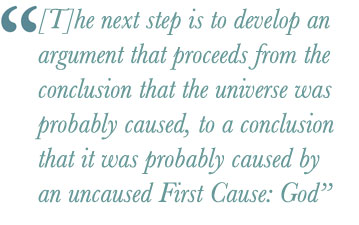 Though the kalam argument logically and evidentially demonstrates that the universe had a beginning and therefore needed a cause, it doesn’t speak directly to what or who caused the universe. Therefore, not only does it not support theism in general, neither does it necessarily assist in the specific case for Christian theism. However, the claim that there was a cause of the universe is consistent with the claim of Christian theism that God created the universe. Therefore, the next step is to develop a line of reasoning that proceeds from the conclusion that the universe was probably caused, to the conclusion that it was probably caused by an uncaused First Cause: The God of Christian Theism.
Though the kalam argument logically and evidentially demonstrates that the universe had a beginning and therefore needed a cause, it doesn’t speak directly to what or who caused the universe. Therefore, not only does it not support theism in general, neither does it necessarily assist in the specific case for Christian theism. However, the claim that there was a cause of the universe is consistent with the claim of Christian theism that God created the universe. Therefore, the next step is to develop a line of reasoning that proceeds from the conclusion that the universe was probably caused, to the conclusion that it was probably caused by an uncaused First Cause: The God of Christian Theism.
NECESSARY PROPERTIES OF A FIRST CAUSE
Based on the conclusion of the kalam argument, the universe could not have always existed. An infinitely existing universe is philosophically untenable and does not concur with the findings of current science, which posits the formation of the universe (i.e., space-time) at a finite moment in the past. Thus, as demonstrated by both philosophical and scientific evidence, the universe cannot be infinite. Since the universe most likely began to exist, it seems reasonable to conclude that some entity13 caused it to exist. I will refer to this entity as the First Cause.14 In the following sections I will suggest some of the necessary properties15 of an entity that caused the universe. Each of the following properties follow from the conclusion of the kalam argument: the universe had a cause of its existence.
Property 1: The First Cause Must Itself be Uncaused
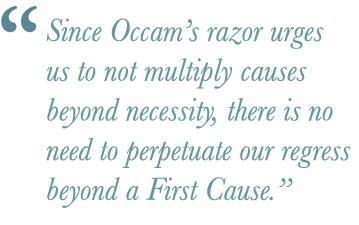 If the universe was caused to exist, then the First Cause must be uncaused (1) because it couldn’t come from nothing and (2) because of the impossibility of an infinite regress. According to Aquinas’s principle of causality, an infinite regress can legitimately halt at a non-contingent, uncaused First Cause. And, since Occam’s razor16 urges us to not multiply causes beyond necessity, there is no need (nor is there any compelling reason) to perpetuate our regress beyond a First Cause. Therefore, the First Cause can be said to have been uncaused.
If the universe was caused to exist, then the First Cause must be uncaused (1) because it couldn’t come from nothing and (2) because of the impossibility of an infinite regress. According to Aquinas’s principle of causality, an infinite regress can legitimately halt at a non-contingent, uncaused First Cause. And, since Occam’s razor16 urges us to not multiply causes beyond necessity, there is no need (nor is there any compelling reason) to perpetuate our regress beyond a First Cause. Therefore, the First Cause can be said to have been uncaused.
Property 2: The First Cause Must Be Beginning-less
The First Cause had no beginning because that which is uncaused does not begin to exist. In other words, if whatever begins to exist has a cause (premise 1 of the kalam argument), then whatever doesn’t have a cause did not begin to exist (the contrapositive of premise 1). The First Cause is not actualized by another because it has never not existed. According to Geisler (2011, 416), if the First Cause (i.e., God) had the potential to not exist (i.e., was contingent), then nothing would have ever existed because something does not come from nothing. In other words, if at one time nothing was in existence, it would have been impossible for anything to have begun to exist; and thus, even now nothing would be in existence (Aquinas, Summa Theologica, Ia, q. 2, art 3). Therefore, the First Cause is a necessary entity, which means that the First Cause cannot not exist. The First Cause must be beginning-less because, by necessity, it must have always existed.
Property 3: The First Cause Must Be Changeless (i.e., immutable)
All matter undergoes change (at least at the molecular level). Since all matter (i.e., contingent substances) began with the space-time universe, whatever existed apart from17 the universe was changeless (immutable) because change is a function of causal relations, which can likely only occur in a space-time universe. Therefore, the First Cause must be changeless.
Property 4: The First Cause Must Be Timeless (i.e., Eternal), Spaceless (i.e., non-spatial) and Immaterial
Time involves change (from one moment to another) and everything that is temporal changes. In the absence of events (i.e., chains of cause and effect) there cannot be time because time is related to causality, which began at the big bang.18 Since time began with the universe, that which existed apart from the universe is timeless. And, whatever existed apart from the space-time universe must also be spaceless (i.e., non-spatial). That is, whatever exists apart from the universe is not limited by space and is, therefore, unlimited in extension (i.e., spaceless). Therefore, since the First Cause existed apart from the universe, it must be timeless (i.e., eternal), non-spatial, and, therefore, immaterial.
Property 5: The First Cause Must Therefore Transcend Space and Time
It follows that if the First Cause is spaceless and timeless then it must also transcend the universe. By “transcendent” I mean an entity that is above, apart from, and beyond the created order. Any entity that could create the physical universe must also exist separate and apart from the created universe and subsequent effects. The creation of the universe required a cause outside of the universe that was itself uncaused, eternal (i.e., not temporal), spaceless (i.e., non-spatial), and immaterial. Thus, causality, time, space, and matter can neither circumscribe nor in any way limit such an entity. The First Cause is transcendent.
Property 6: The First Cause Must Be All-Powerful
Any entity that could bring about the universe, in all its physical reality, including space, time, energy, and matter, would have to be all-powerful, or at very least powerful enough to have created the universe. In causal terms, this entity would be entirely sufficient for this purpose (i.e., capable of bringing forth the universe without material cause).
Property 7: The First Cause Must Be Personal
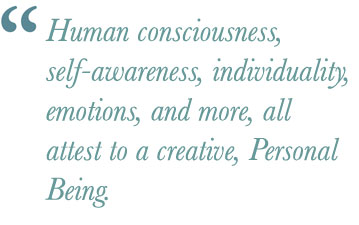 Philosopher Richard Swinburne (as cited in Craig and Sinclair 2012, Kindle Locations 5080-5082), points out that there “are two types of causal explanation: scientific explanations in terms of laws and initial conditions and personal explanations in terms of agents and their volitions” (italics added). Craig and Sinclair (2012) add that: “A first state of the universe cannot have a scientific explanation, since there is nothing before it, and therefore, it cannot be accounted for in terms of laws operating on initial conditions” (Kindle Locations 5086-5087). Therefore, the cause of the universe can only be accounted for by a personal agent and its volitions. In other words, science does not provide explanations of things that precede the natural world (i.e., science only describes the conditions after the beginning of the universe). Such a personal First Cause is consistent with the existence of other personal beings in the universe. That such a Being created other beings capable of love, hope, and other personal interactions, better explains the appearance of personal beings than does impersonal matter. The unique existence of mankind is evidence that a personal entity was involved in creation. Human consciousness, self-awareness, individuality, emotions, and more, all attest to a creative, personal Being. Emotions, rational thought, and personal relationships are not reducible to biochemical and physiological reactions and therefore are not a product of impersonal matter (Diaz 2018b).
Philosopher Richard Swinburne (as cited in Craig and Sinclair 2012, Kindle Locations 5080-5082), points out that there “are two types of causal explanation: scientific explanations in terms of laws and initial conditions and personal explanations in terms of agents and their volitions” (italics added). Craig and Sinclair (2012) add that: “A first state of the universe cannot have a scientific explanation, since there is nothing before it, and therefore, it cannot be accounted for in terms of laws operating on initial conditions” (Kindle Locations 5086-5087). Therefore, the cause of the universe can only be accounted for by a personal agent and its volitions. In other words, science does not provide explanations of things that precede the natural world (i.e., science only describes the conditions after the beginning of the universe). Such a personal First Cause is consistent with the existence of other personal beings in the universe. That such a Being created other beings capable of love, hope, and other personal interactions, better explains the appearance of personal beings than does impersonal matter. The unique existence of mankind is evidence that a personal entity was involved in creation. Human consciousness, self-awareness, individuality, emotions, and more, all attest to a creative, personal Being. Emotions, rational thought, and personal relationships are not reducible to biochemical and physiological reactions and therefore are not a product of impersonal matter (Diaz 2018b).
Properties of First Cause are Consistent with Attributes of the God of Christian Theism
Each of the seven properties listed above describe the necessary characteristics of the First Cause. And, as it so happens, the Bible affirms these same characteristics of the God of Christian theism. The Bible describes God as:
- Uncaused: He has no potency (i.e., potentiality), no possibilities, only actualities (Ex. 3:14; Ps. 90:2; Mal. 3:6).
- Beginningless and Self-existent (Gen. 1:1; Ex. 3:14; Acts 17:25; Rev. 1:8).
- Changeless (Num. 23:19; Mal. 3:6; Heb. 1:12; Ja. 1:17)
- Timeless (Gen. 1:1; Gen. 21:23; Ps. 90:2; Isa. 57:15; 1 Cor. 2:7; 1 Tim. 1:17; Rev. 1:8), Spaceless (1 Kings 8:27; 2 Chron. 2:6; Ps. 97:9; Jer. 23:24; Eph. 4:6), and Immaterial (Deut. 4:12; John 4:24; Col. 1:15; 1 Tim. 1:17).
- Transcendent (Gen. 1:1; 1 Kings 8:27; Ps. 97:9; Isa. 55:8–9; Eph. 4:6; Col 1:17).
- All-powerful (Job 11:7–11; Jer. 49:19; Ps. 115:3; Ps. 135:6; Heb. 1:3; Luke 1:37; Luke 18:27).
- Personal: an individual who can act intentionally and who has purposes and beliefs (see Geisler 2011, 546–547). The God of Christian theism is described as a triunity: three persons in one essence. Each of the persons of the triune God is described as having requisite attributes of personhood: intellect, emotions, and will. Thus, the Father is a person: He has the power of intellect (Matt. 6:32); He can feel and has emotions (Gen. 6:6); He has the power of volition or will (Matt. 6:9–10); and He has the ability to teach (John 7:16–17) and communicate (Matt. 11:25). The Son is a person: He can communicate and teach (John 7:17); He has intellect (John 2:25) and feeling (John 11:35). And He has volition or a will (John 6:38). The Holy Spirit is a person: He has a mind (John 14:26); He has a will (1 Cor. 12:11), and He has feelings (Eph. 4:30).
CONCLUSION
The outcome of the kalam argument cries out for a coherent hypothesis for the cause of the universe. I have shown that there are good reasons to believe that the universe had a cause and that this First Cause necessarily possesses many of the same characteristics as the God of Christian theism. These characteristics are described in detail in the Bible and support a conclusion that the God of Christian theism is the First Cause of the universe.
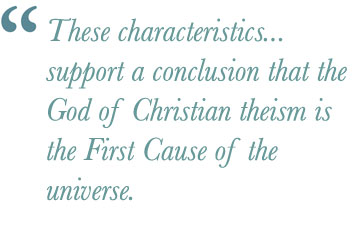 There are not a lot of world views besides Christian theism that provide a coherent, rational answer to the origin of the universe. An atheistic world view typically relies on science for its answers and yet, as noted earlier, since science deals exclusively with the material world and not the “nothingness” that existed apart from the beginning of the universe, science cannot offer a scientific explanation for the origin of the universe. Naturalistic atheism usually adheres to some form of materialism/physicalism19 as its sustaining world view. Naturalistic (i.e., atheistic) arguments are merely irrational appeals to blind materialistic causes and typically provide no compelling rational hypothesis for the cause of the universe. But blind matter cannot be responsible for the universe. The physical world depends on the laws of nature, but these laws alone cannot account for the creation and maintenance of the universe. Thus, neither the universe nor the laws of nature can be the cause of the universe and the laws of nature. In other words, they cannot have been their own cause. As stated by Diaz (2017a): “Materialism is a self-defeating dogma, for, by its entailment of thoroughgoing determinism, it cannot be known to be true. In fact, it nullifies itself by precluding both rational justification and knowledge, making it impossible to explain ultimate origins.”
There are not a lot of world views besides Christian theism that provide a coherent, rational answer to the origin of the universe. An atheistic world view typically relies on science for its answers and yet, as noted earlier, since science deals exclusively with the material world and not the “nothingness” that existed apart from the beginning of the universe, science cannot offer a scientific explanation for the origin of the universe. Naturalistic atheism usually adheres to some form of materialism/physicalism19 as its sustaining world view. Naturalistic (i.e., atheistic) arguments are merely irrational appeals to blind materialistic causes and typically provide no compelling rational hypothesis for the cause of the universe. But blind matter cannot be responsible for the universe. The physical world depends on the laws of nature, but these laws alone cannot account for the creation and maintenance of the universe. Thus, neither the universe nor the laws of nature can be the cause of the universe and the laws of nature. In other words, they cannot have been their own cause. As stated by Diaz (2017a): “Materialism is a self-defeating dogma, for, by its entailment of thoroughgoing determinism, it cannot be known to be true. In fact, it nullifies itself by precluding both rational justification and knowledge, making it impossible to explain ultimate origins.”
On the other hand, of the major religious world views (including pantheism and polytheism), Christian theism is one of the only views that takes objective truth and rationality seriously. Religions of the East (Hinduism, Jainism, Zen Buddhism, Sikhism, Confucianism, Taoism, Chinese folk religion, etc.) have, in general, not been concerned with demonstrating the truth or rationality of their own views. Indeed, reason typically plays a much smaller role in Eastern religions, which favor direct, intuitive experience. But for Christianity, truth is objective and has correspondence to the real world (see Diaz 2017c). For the Christian theist, truth is objective because God’s word is truth (Ps. 119:160; John 17:17) and because God exists as an objective being. Christian theism represents the best explanation for the origin of the universe when compared with other world views. In other words, when compared with other proposed causes of the cosmos, Christian theism presents us with a rationally viable answer not only for questions regarding the existence of the universe but also for the principal features of the universe (e.g., the existence of life and intelligent beings, the distinction between mind and matter, freedom of choice, a sense of objective moral standards, etc.).
In conclusion, the universe that we live in is finite and therefore needed a cause to exist. The whole of reality can be sufficiently explained only by a cause and ground that is transcendent to the universe. That is, the universe couldn’t have caused itself, nor did it suddenly emerge out of nothing, but must have been caused by something other. Christian theism asserts that the cause and ground of the universe is the uncaused Creator God described in the Bible (Ps. 90:2). Thus, the assertion that God caused the universe is a simple, reasonable, and intellectually satisfying answer to the question of the origin of the universe.
References Cited
Aquinas, Thomas. Summa theologica. Translated by Fathers of the English Dominican Province. New York: Benziger Brothers, 1911-1925.
Carroll, Sean M. The Big Picture: on the Origins of Life, Meaning, and the Universe Itself. New York, NY: Dutton, 2017.
Craig, William Lane. “The Kalam Cosmological Argument.” In Christian Apologetics: An Anthology of Primary Sources, edited by K. A. Sweis and C. V. Meister, 81–93. Grand Rapids, MI: Zondervan, 2012.
Craig, William Lane; Sinclair, James D. “The Kalam Cosmological Argument.” chap. 3 in The Blackwell Companion to Natural Theology, edited by Craig, W. L.; Moreland, J. P. Chichester, UK: Wiley-Blackwell, 2012.
Davies, P. God and the New Physics. New York, NY: Simon & Schuster, 1984.
——— “Emergent Complexity, Teleology, and the Arrow of Time.” In Debating Design: From Darwin to DNA, edited by W. A. Dembski and M. Ruse, 190–210. Cambridge, UK: Cambridge University Press, 2004.
Diaz, D. P. “God v. Matter as the Cause of the Universe – Part 1.” Things I Believe Project. June 15, 2017. http://thingsibelieveproject.net/god-v-matter-as-the-cause-of-the-universe-part-1/.
——— “God v. Matter as the Cause of the Universe – Part 2.” Things I Believe Project. June 25, 2017b. http://thingsibelieveproject.net/god-v-matter-as-the-cause-of-the-universe-part-2/.
——— “Absolute Truth? Absolutely!” Things I Believe Project. August 14, 2017c. http://thingsibelieveproject.net/absolute-truth-absolutely/.
Dienes, K. R. “Rethinking the Rules of Reality.” Address presented at University of Arizona lecture series 2017 Rethinking Reality, June 12, 2017.
Geisler, Norman L. Systematic Theology: in One Volume. Minneapolis, MN: Bethany House Publishers, 2011.
Geisler, Norman L., and William D. Watkins. Worlds Apart: a Handbook on World Views. Eugene, OR: Wipf and Stock Publishers, 2003.
Hossenfelder, Sabine. Lost in Math: How Beauty Leads Physics Astray. New York, NY: Basic Books, 2018.
Hume, David. David Hume: Dialogues concerning Natural Religion in Focus. Edited by Stanley Tweyman. London: Routledge, 2013.
Leibniz, Gottfried Wilhelm, and Leroy E. Loemker. Philosophical Papers and Letters; of G.W. Leibnitz. A Selection Trans. and Ed. Dordrecht: Reidel, 1969.
Moreland, J. Scaling the Secular City: A Defense of Christianity. Grand Rapids, MI: Baker Academic, 1987.
About the Author [back to top]
David P. Diaz, Ed.D. is the publisher and owner of Things I Believe Project. An educator and author, Dr. Diaz has a lifelong love of learning. His pen name (aka “Don Quixote”) comes from his love of chasing windmills (i.e., truth and other ideals) and his penchant for tongue-in-cheek humor: “Don Quixote was developing his arguments in such an orderly and lucid way that for the time being none of those listening could believe he was a madman.”
Footnotes
- Christian theism, among other tenets, holds that there is one God and three persons (a triunity) who is the creator of all things. This God is a personal being, eternal (i.e., timeless), all-powerful, all-knowing, perfectly good, transcendent, and completely free to do anything that is consistent with His nature. In this article, I will be attempting to demonstrate the likely existence of the God of Christian theism.
- Portions of this paper were adapted from a chapter in my forthcoming book, The Genesis Labyrinth.
- A worldview represents a philosophical framework from which we view reality and make sense of life and the world. Our own worldview is a set of propositions (a proposition is the meaning of a statement that expresses something that can be true or false) that we believe to be true about the world. This personal view, and the process by which one comes to hold it, can be especially crucial when it concerns life’s most important questions: What happens after death? What is truth and how do we apprehend it? And many others. Seven major worldviews include Theism, Atheism, Pantheism, Panentheism, Polytheism, Deism, and Finite Godism.
For more on worldviews see Geisler, Norman L., and William D. Watkins. Worlds Apart: A Handbook on World Views. Eugene, OR: Wipf and Stock Publishers, 2003.
- Contingent beings are those that could not have existed on their own (i.e., they need a prior cause) and are therefore dependent on something else for their existence.
- Thomas Aquinas, Summa theologica, trans. Fathers of the English Dominican Province (New York: Benziger Brothers, 1911-1925), Ia, q. 2, arts 3.
- The kalam (the word refers to Islamic scholastic theology) cosmological argument, which likely had its beginning in the works of Christian philosopher John Philoponus (AD 490–570), became popular among Arabic philosophers in the late middle ages. The argument has been developed further in recent years by William Lane Craig (2012, 81–93).
- If one does not think that the universe has always existed—that is, if one already believes that the world came into existence at a point in time in the finite past—then the kalam argument is unnecessary. The reader can move on to the section of this paper titled: “Necessary Properties of a First Cause.” Indeed, an eternal universe theory has not been a commonly held belief since the big bang theory has become the consensus position of science.
- There are different statements of the kalam argument; this is, I think, its
simplest form. - Singularity is “a point at which a function takes an infinite value, especially in space-time when matter is infinitely dense, as at the centre of a black hole” (Oxford Living Dictionaries, s.v. “singularity”). Infinite, in this sense, refers to the point where the laws of physics break down. That point represents the boundary of time in which space no longer exists. Some quantum cosmology models introduce “imaginary numbers” for the time variable in the Standard gravitational equations. This effectively eliminates a singularity in the model. However, it does not contradict the assertion that the universe had a beginning. There would still be a beginning, albeit without a singularity.
- A closed system refers to a hypothetical universe that has no mass being fed into or out of it. The universe has a finite size and contains sufficient density/gravitational force to stop (or reverse) the expansion that commenced at the big bang.
- Another option is a hypothesized oscillating universe theory. In this scenario, after an expansion/crunch cycle, the highly condensed cosmos, rather than imploding into oblivion, will “bounce” at a certain density and begin a new and continuing cycle of expansion/contraction. Paul Davies (1984) has discussed the problems with this theory in his book God and the New Physics.
- Hossenfelder appropriately qualifies her statement: “The existing predictions demonstrate that the multiverse is in principle amenable to experimental test, but these tests are useful only for very specific scenarios” (p. 107).
- An “entity” can be defined as “a thing with distinct and independent existence.”
- The First Cause is an “entity” (see above footnote). At this point, I am not attributing any particular properties (other than existence) to this entity.
- The following properties were adapted from Craig, William Lane; Sinclair, James D. “The Kalam Cosmological Argument,” chap. 3 in The Blackwell Companion to Natural Theology, edited by Craig, William Lane; Moreland, J. P. Chichester, UK: Wiley-Blackwell, 2012.
- This principle has been employed by science as part of a set of criteria that can be used to decide the probable truth of a proposed theory, law, or hypothesis. Although Occam’s razor has an important role, if used critically, one must always be wary of substituting simplicity for truth. The simple is not always the truth, and the truth is not always simple.
- Although it is common to talk about the conditions on the other side of the boundary of the universe as being “prior to” the existence of the universe, technically, this may be inaccurate. Since time began at the initiation of the universe, it may be meaningless to talk about any condition as “before” the universe. Thus, I will use the term “apart from” to refer to the conditions outside of time, space, and matter.
- This assumes some kind of dynamic theory of time.
- Materialism is a philosophical theory that claims that all reality consists of one kind of thing and that all distinctions in the world are nothing more than various alterations of the basic physical substrate. Many philosophers prefer to call the view “physicalism” because this term is more inclusive, encompassing not only material entities that are spatially extended but also fields and forces. Materialism essentially agrees with monism, which is a theory or doctrine that denies distinction or duality in some sphere. Its main assumptions preclude any distinction between mind and matter and between God (or any metaphysical entity) and the universe.